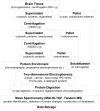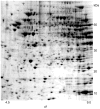Genetics, transcriptomics, and proteomics of Alzheimer's disease
- PMID: 16669732
- PMCID: PMC2259384
- DOI: 10.4088/jcp.v67n0418
Genetics, transcriptomics, and proteomics of Alzheimer's disease
Abstract
Objective: To provide an updated overview of the methods used in genetic, transcriptomic, and proteomic studies in Alzheimer's disease and to demonstrate the importance of those methods for the improvement of the current diagnostic and therapeutic possibilities.
Data sources: MEDLINE-based search of 233 peer-reviewed articles published between 1975 and 2006.
Data synthesis: Alzheimer's disease is a genetically heterogeneous disorder. Rare mutations in the amyloid precursor protein, presenilin 1, and presenilin 2 genes have shown the importance of the amyloid metabolism for its development. In addition, converging evidence from population-based genetic studies, gene expression studies, and protein profile studies in the brain and in the cerebrospinal fluid suggest the existence of several pathogenetic pathways such as amyloid precursor protein processing, beta-amyloid degradation, tau phosphorylation, proteolysis, protein misfolding, neuroinflammation, oxidative stress, and lipid metabolism.
Conclusions: The development of high-throughput genotyping methods and of elaborated statistical analyses will contribute to the identification of genetic risk profiles related to the development and course of this devastating disease. The integration of knowledge derived from genetic, transcriptomic, and proteomic studies will greatly advance our understanding of the causes of Alzheimer's disease, improve our capability of establishing an early diagnosis, help define disease subgroups, and ultimately help to pave the road toward improved and tailored treatments.
Figures



Comment in
-
In this issue: The genetic, transcriptomic, and proteomic study of Alzheimer's disease.J Clin Psychiatry. 2006 Apr;67(4):650-1. doi: 10.4088/jcp.v67n0417. J Clin Psychiatry. 2006. PMID: 16669731 No abstract available.
References
-
- Evans DA, Funkenstein HH, Albert MS, et al. Prevalence of Alzheimer’s disease in a community population of older persons. Higher than previously reported. JAMA. 1989;262:2551–2556. - PubMed
-
- Gatz M, Pedersen NL, Berg S, et al. Heritability for Alzheimer’s disease: the study of dementia in Swedish twins. J Gerontol A Biol Sci Med Sci. 1997;52:M117–M125. - PubMed
-
- Heston LL, Mastri AR, Anderson VE, et al. Dementia of the Alzheimer type. Clinical genetics, natural history, and associated conditions. Arch Gen Psychiatry. 1981;38:1085–1090. - PubMed
-
- Heyman A, Wilkinson WE, Hurwitz BJ, et al. Alzheimer’s disease: genetic aspects and associated clinical disorders. Ann Neurol. 1983;14:507–515. - PubMed
-
- Breitner JC, Folstein MF. Familial Alzheimer Dementia: a prevalent disorder with specific clinical features. Psychol Med. 1984;14:63–80. - PubMed
Publication types
MeSH terms
Substances
Grants and funding
LinkOut - more resources
Full Text Sources
Other Literature Sources
Medical

